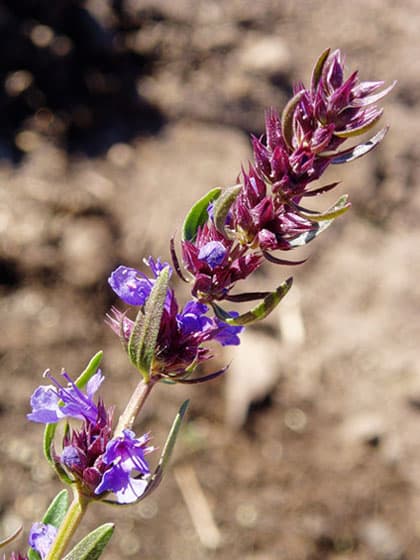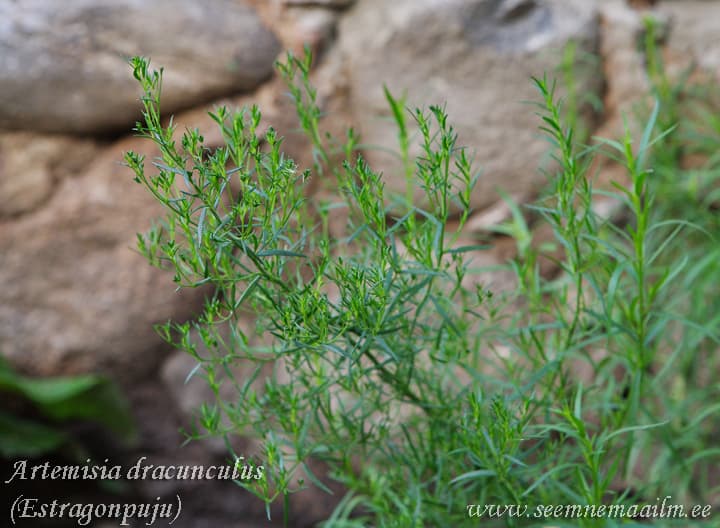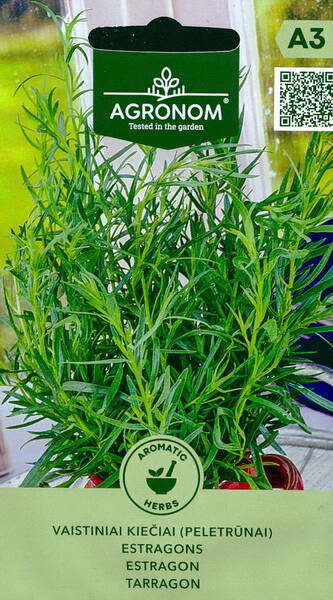Ex Tax: 0.85€
Young shoots are used in cooking as a seasoning and as a medicinal plant (improves digestion, appetite).
Sowing for seedlings in boxes in early March (shoots appear after 14-20 days), followed by picking into a nursery according to the 5x5 cm pattern. After 60 days, the seedlings are planted in a permanent place according to the 60x30 cm pattern.
It winters well in open ground, is not demanding to soils (but does not tolerate waterlogged and acidic soils). It can grow in one place for 8-10 years.
Tarragon is a perennial herbaceous plant with straight stems and long narrow leaves.
Small flowers are collected in a narrow panicle, which blooms in the second half of summer.
Tarragon is propagated by seeds (1.0 g = 5000 seeds), which are first sown in boxes to obtain seedlings, and vegetatively - by dividing the bushes, root suckers and stem cuttings. The bushes are dug up in early spring and divided into several parts, each with at least 3-5 shoots. They are planted in a new place in April - May.
Due to the aroma caused by essential oils, tarragon herb serves as a spice and is used in cooking in fresh and dried form. Tarragon is valued not only for its spicy flavour but also for its vitamin C and carotene content.
Fragrant tarragon, like other leafy spices, gives a person vigour. It is used as a vitamin medicinal plant.
Traditional medicine notes its antiscorbutic, diuretic and tonic effect on the body. Essential oil is used in perfumery. Tarragon is not hot spicy, but highly aromatic.
In Russian families, dill is usually served, while Armenians and Georgians have their own favorite herb - tarragon or little dragon.
Young, non-woody herbaceous shoots and leaves of tarragon are used in salads, with cheese, sour milk, and simply as table greens. Older shoots are irreplaceable as spices in pickles and marinades. It is worth trying mushrooms, cucumbers, tomatoes, peppers, or squash pickled with tarragon, after which you will constantly want to use it for these purposes...
Tarragon, thanks to its aroma and spicy qualities, is necessary for canning like no other plant. A few sprigs of tarragon are enough to get a unique piquant taste.


Little dragon, Russian tarragon. Bot. syn.: Artemisia dracunculoides Pursh., Artemisia redowskii Ledeb., Oligosporus dracunculus L.
* Tarragon is most useful in the first three to four years, although it can grow in one place for up to 10 years. Despite the fact that tarragon growing in the garden is very long-lived when growing it at home, it is worth considering the following.
To grow tarragon in containers, you need to choose a large tub or a deep flower box. Prepare humus-rich soil, make drainage holes in the bottom of the tub or box, because the roots of the plant need oxygen, and they do not tolerate stagnant water, but prefer moderately moist soil. Do not let the soil dry out completely, water the plant regularly.
Plants growing in pots should be kept in partial shade so that the soil retains moisture longer. However, you should not choose a too shaded place, because then the tarragon leaves lose their characteristic aroma.
Tear off leaves and shoots so that the plant is bushy. Tarragon can also overwinter outdoors if you place it in a place protected from the wind and cover it with spruce branches.
After two or three years, the plant weakens, and its shoots gradually become bare. Tarragon can be divided and replanted, or new plants can be grown from apical cuttings (To take cuttings, cut off the tops of the shoots 8 cm long from the plant in early summer. Remove the lower leaves. Stick the cuttings into a pot with soil, cover it with a bag and place it in a shady place. When the cutting produces shoots, you can remove the plastic bag).
It is recommended to use fresh leaves and shoots for food since they lose their aroma when they dry out (from June, you can pinch off fresh leaves and tops of tarragon shoots).
Tarragon can be frozen in ice cubes. Tarragon essential oil is used to make vinegar. You can also infuse vinegar with tarragon at home. To do this, place freshly picked tarragon shoots in white wine vinegar, which has a mild taste. You will get a piquant vinegar if, in addition to tarragon, you add rosemary, bay leaves and dill umbrellas to the vinegar.












